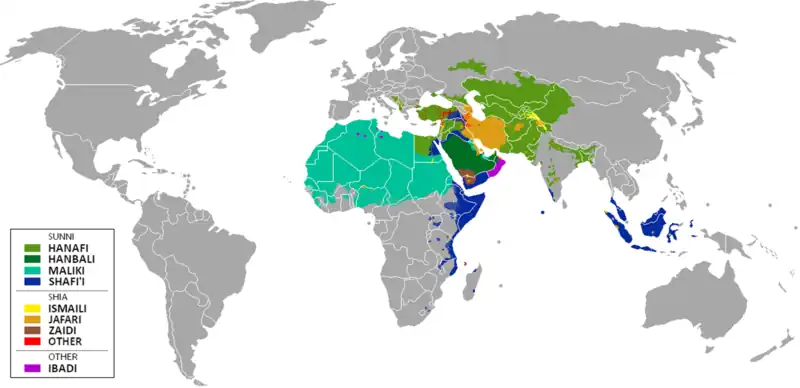al-Imām al-Aʿẓam Abū Ḥanīfa | |
|---|---|
| Personal | |
| Born | 697 (80 Hijri) Kufa, Umayyad Caliphate |
| Died | 767 (150 Hijri) Baghdad, Abbasid Caliphate |
| Resting place | Abu Hanifa Mosque, Baghdad, Iraq |
| Religion | Islam |
| Children | Hammad |
| Era | Islamic golden age |
| Region | Kufa[1] |
| Denomination | Sunni Hanafi |
| Jurisprudence | Ijtihad |
| Main interest(s) | Jurisprudence |
| Notable idea(s) | Istihsan |
| Notable work(s) | al-Fiqh al-Akbar, Musnad Abu Hanifa, Kitab al-Athar |
| Muslim leader | |
Influenced by | |
Influenced | |
Nuʿmān ibn Thābit ibn Zūṭā ibn Marzubān (Arabic: نعمان بن ثابت بن زوطا بن مرزبان; c. 696–767), commonly known by his kunya Abū Ḥanīfa (Arabic: أبو حنيفة), or reverently as Imam Abū Ḥanīfa by Sunni Muslims,[2] was a Muslim theologian and jurist[3] who became the eponymous founder of the Hanafi school of Sunni jurisprudence, which has remained the most widely practised school of law in the Sunni tradition.[3] The school of thought predominates in Central Asia, Afghanistan, Iran (until the 16th century), Turkey, the Balkans, Russia, Circassia, Pakistan, Bangladesh, Muslims in India, and some parts of the Arab world.[4][5] He is also widely called al-Imām al-Aʿẓam ("The Greatest Imam") and Sirāj al-Aʾimma ("The Lamp of the Imams") by Sunni Muslims.[6][3]
Born to a Muslim family in Kufa,[3] Abu Hanifa is known to have travelled to the Hejaz region of Arabia in his youth, where he studied in Mecca and Medina.[3] As his career as a theologian and jurist progressed, Abu Hanifa became known for favouring the use of reason in his legal rulings (faqīh dhū raʾy) and even in his theology.[3] Abu Hanifa's school of theology would later develop into the Maturidi school of Sunni theology.[3]
Life
Family background
Abu Hanifa was born in Kufa in 80 AH,[7][8] 77 AH,[9] 70 AH,[10] or 61 AH,[11] during the period of the Umayyad Caliphate. Many historians choose the latest date of birth, 80 AH. But Mohammad Zahid Al-Kawthari, adjunct to the office of the last Shaykh Al-Islam of the Ottoman Empire, wrote that 70 AH as the date of his birth is supported by two considerations. Firstly, Mohammad Ibn Makhlad Al-Attar considered the narration of Abu Hanifa’s son, Hammad, from Imam Malik Ibn Anas to be an example of an older man's narration rather than a younger man. Secondly, Abu Hanifa was concerned with who should succeed Ibrahim Al-Nakhai after his death in 96 AH. Abu Hanifa's concern about the succession would only have arisen if Abu Hanifa was older than 19, since it is considered that Abu Hanifa only took his religious studies seriously after he was about 19. If Abu Hanifa was born in 80 AH, Abu Hanifa would have been 16 at the time of Al-Nakhai's death.[12]
Abu Hanifa is thought to be of Persian ancestry.[6][13] However, he has also been stated to have descended from the Zuṭṭ, Jats who had migrated into Iraq during the Islamic Golden Age.[14][15][16] His grandfather, Zūtā, may have been captured by Muslim troops in Kabul and sold as a slave in Kufa. There, he was purchased and freed by an Arab tribesman of the Taymallah, a branch of the Banu Bakr. Zūtā and his progeny thereafter would have become clients (mawali) of the Taymallah, hence the sporadic references to Abu Hanifa as 'al-Taymi'.[17] According to Abu Hanifa's grandson Ismail, however, his lineage went back to free Persians who had never been held as slaves. He called Abu Hanifa's great-grandfather "al-Marzuban", which is an arabicised form of the Sasanian military office of marzban, held by governors of the frontier provinces of the Sasanian realm.[2]
Early life and scholarship
There is scant biographical information about Abu Hanifa. It is generally known that he worked a producer and seller of "khazz", a type of silk clothing material. He attended lectures on jurisprudence conducted by the Kufan scholar Hammad ibn Abi Sulayman (d. 737).[17] He also possibly learnt jurisprudence (fiqh) from the Meccan scholar Ata ibn Abi Rabah (d. c. 733) while on Hajj.
When Hammad died, Abu Hanifa succeeded him as the principal authority on Islamic law in Kufa and the chief representative of the Kufan school of jurisprudence.[17] Abu Hanifa gradually gained influence as an authority on legal questions, founding a moderate rationalist school of Islamic jurisprudence that was named after him.[5]
Adulthood and death
In 763, al-Mansur, the Abbasid caliph offered Abu Hanifa the post of qadi al-qudat (chief judge of the state), but he declined the offer, choosing to remain independent. His student Abu Yusuf was later appointed to the post by Caliph Harun al-Rashid.[18]
In his reply to al-Mansur, Abu Hanifa said that he was not fit for the post. Al-Mansur, who had his own ideas and reasons for offering the post, lost his temper and accused Abu Hanifa of lying.
"If I am lying," Abu Hanifa responded, "then my statement is doubly correct. How can you appoint a liar to the exalted post of a Qadi (Chief Judge)?"
Incensed by this reply, al-Mansur had Abu Hanifa arrested, locked in prison and tortured. It was said that once in prison he was never fed nor cared for.[19] Even in prison, the jurist continued to teach those who were permitted to visit him.
On 15 Rajab 150,[20] (15 August 767[21]) Abu Hanifa died in prison. The cause of his death is not clear, as it was said by some that Abu Hanifa issued a legal opinion for bearing arms against al-Mansur, so al-Mansur had him poisoned.[22] His fellow prisoner and founder of Karaite Judaism, Anan ben David, was said to have received life-saving counsel from Abu Hanifa.[23] It was said that so many people attended his funeral that the funeral service was repeated six times for the more than 50,000 people who had massed before he was actually buried. The historian al-Khatib said that for a full 20 days people performed funeral prayers for him. Many years later, the Abu Hanifa Mosque was built in the Adhamiyah neighbourhood of Baghdad. Abu Hanifa also supported the cause of Zayd ibn Ali and Ibrahim al Qamar, both Alid Zaydi Imams.
The structures of the tombs of Abu Hanifa and Abdul Qadir Gilani were destroyed by Shah Ismail of the Safavid Empire in 1508.[24] In 1533, the Ottomans conquered Baghdad and rebuilt the tombs of Abu Hanifa and Abdul Qadir, as well as other Sunni sites.[25]
Students
Yusuf ibn Abd al-Rahman al-Mizzi listed 97 hadith scholars who were his students. Most of them went on to be hadith scholars, and their narrated hadiths were compiled in the Sahih al-Bukhari, Sahih Muslim and other books of hadith.[26] Imām Badr al-Din al-Ayni included another 260 students who studied Hadith and Fiqh with Abu Hanifa.[27]
His most famous students were Imām Abu Yusuf, who served as the first chief justice in the Muslim world, and Imām Muhammad al-Shaybani, who was the teacher of the Shafi‘i school of jurisprudence founder, Imām Al-Shafi‘i. His other students included Abdullah ibn Mubarak and Fudhayl bin Iyaadh[28]
Sources and methodology
The sources from which Abu Hanifa derived Islamic law, in order of importance and preference, were: the Qur'an, the authentic narrations of the Muslim prophet Muhammad (known as hadith), consensus of the Muslim community (ijma), analogical reasoning (qiyas), juristic discretion (istihsan) and the customs of the local population enacting Muslim laws (urf). The development of analogical reason and the scope and boundaries by which it may be used was recognized by the majority of Muslim jurists, but its establishment as a legal tool was the result of the Hanafi school. While it was likely used by some of his teachers, Abu Hanifa is regarded by modern scholarship as the first to formally adopt and institute analogical reason as a part of Islamic law.[29]
As the fourth Caliph, Ali had transferred the Islamic capital to Kufa, and many of the first generation of Muslims had settled there. The Hanafi school of law based many of its rulings on the prophetic tradition as transmitted by those first generation Muslims residing in Iraq. Thus, the Hanafi school came to be known as the Kufan or Iraqi school. Ali and Abdullah, son of Masud helped form much of the base of the school, as well as other personalities from the direct relatives (or Ahli-ll-Bayṫ) of Moḥammad from whom Abu Hanifa had studied such as Muhammad al-Baqir. Many jurists and historians had reportedly lived in Kufa, including one of Abu Hanifa's main teachers, Hammad ibn Abi Sulayman.[30][31]
Generational status
Abu Hanifa is regarded by some authorities as one of the Tabi‘un, the generation after the Sahaba, who were the companions of the Islamic prophet, Muhammad. This is based on reports that he met at least four Sahaba including Anas ibn Malik,[32] with some even reporting that he transmitted Hadith from him and other companions of Muhammad.[33][34] Others take the view that Abu Hanifa only saw around half a dozen companions, possibly at a young age, and did not directly narrate hadith from them.[33]
Abu Hanifa was born at least 60 years after the death of Muhammad, but during the time of the first generation of Muslims, some of whom lived on until Abu Hanifa's youth. Anas ibn Malik, Muhammad's personal attendant, died in 93 AH and another companion, Abul Tufail Amir bin Wathilah, died in 100 AH, when Abu Hanifa was at least 20 years old. The author of al-Khairat al-Hisan collected information from books of biographies and cited the names of Muslims of the first generation from whom it was reported that the Abu Hanifa had transmitted hadith. He counted 16 of them, including Anas ibn Malik, Jabir ibn Abd-Allah and Sahl ibn Sa'd.[35]
Reception

He was highly regarded across the various fields of sacred knowledge and significantly influenced the development of Muslim theology.[36] During his lifetime, he was acknowledged as a jurist of the highest calibre.[37]
Outside of his scholarly achievements, Abu Hanifa is popularly known amongst Sunni Muslims as a man of the highest personal qualities: a performer of good works, remarkable for his self-denial, humble spirit, devotion and pious awe of God.[38]
His tomb, surmounted by a dome erected by admirers in 1066 is still a shrine for pilgrims.[39] It was restored in 1535 by Suleiman the Magnificent after the Ottoman conquest of Baghdad.[25]
The honorific title al-Imam al-A'zam ("the greatest leader") has been granted to him[40] in many communities where his legal theory is followed. According to John Esposito, 45% of all Muslims follow the Hanafi school.[41]
Abu Hanifa also had his critics. The Zahiri scholar Ibn Hazm quoted Sufyan ibn `Uyaynah: "[T]he affairs of men were in harmony until they were changed by Abù Hanìfa in Kùfa, al-Batti in Basra and Màlik in Medina".[42] Early Muslim jurist Hammad ibn Salamah once related a story about a highway robber who posed as an old man to hide his identity; he then remarked that were the robber still alive he would be a follower of Abu Hanifa.[43]
Zakaria bin Muhammad Amin credited Abu Hanifa as one of the best figures in the implementation of Islamic brotherhood due to never considers his opinion to be the most correct and instead suggests discarding his opinion if there is more correct opinion.[44]
Connection with the family of Muhammad
| |||||||||||||||||||||||||||||||||||||||||||||||||||||||||||||||||||||||||||||||||||||||||||||||||||||||||||||||||||||||||||||||||||||||||||||||||||||||||||||||||||||||||||||||||||||||||||||||||||||||||||||||||||||||||||||||||||||||||||||||||||||||||||||||||||||||||||||||||||||||||||||||||||||||||||||||||||||||||||||||||||||||||||||||||||||||||||||||||||||||||||||||||||||||||||||||||||||||||||||||||||||||||||||||||||||||||||||||||||||||||||||||||||||||||||||||||||||||||||||||||||||||||||||||||||||||||||||||||||||||||||||||||||||||||||||||||||||||||||||||||||||||||||||||||||||||||||||||||||||||||||||||||||||||||||||||||||||||||||||||||||||||||||||||||||||||||||||||||||||||||||||||||||||||||||||||||||||||||||||||||||||||||||||||||||||||||||||||||||||||||||||||||||||||||||||||||||||||||||||||||||||||||||||||||||||||||||||||||||||||||||||||||||||||||||||||||||||||||||||||||||||||||||||||||||||||||||||||||||
As with Malik ibn Anas (who was a teacher of Imam al-Shafi'i,[45][46]: 121 who in turn was a teacher of Sunni Imam Ahmad ibn Hanbal), Imam Abu Hanifa was a student of Ja'far al-Sadiq, who was a descendant of the Islamic Nabi (prophet) Muhammad. Thus all of the four great Imams of Sunni Fiqh are connected to Ja'far from the Bayt (Household) of Muhammad, whether directly or indirectly.[47]
In one hadith, Abu Hanifa once said about Imam Ja'far: "I have not seen anyone with more knowledge than Ja'far ibn Muhammad."[48] However, in another hadith, Abu Hanifa said: "I met with Zayd (Ja'far's uncle) and I never saw in his generation a person more knowledgeable, as quick a thinker, or more eloquent than he was."[49]
Opposition to deviations in belief
Imam Abu Hanifa was quoted as saying that Jahm ibn Safwan (d. 128/745) went so far in his denial of anthropomorphism (Tashbih) as to declare that 'God is not something (Allah laysa bi shay')'. Muqatil ibn Sulayman (d. 150/767), likened God to His creatures.[50]
Al-Khatib al-Baghdadi narrated in his Tarikh Baghdad (History of Baghdad) that Imam Abu Hanifa said:
Two groups of the worst of people are from Khurasan: the Jahmiyyah (followers of Jahm ibn Safwan) and the Mushabbihah (antropomorphists), and he probably said (instead of Mushabbihah) "Muqatiliyyah" (followers of Muqatil ibn Sulayman).[51][52][53]
Works
| Title | Description |
|---|---|
| Al-Fiqh al-Akbar | |
| Al-Fiqh al-Absat | |
| Kitaab-ul-Aathaar | Narrated by Imam Muhammad al-Shaybani & Imam Abu Yusuf – compiled from a total of 70,000 hadith |
| Al-Wasiyyah | |
| At Tareeq Al Aslam Musnad Imam Abu Hanifah |
Confusion regarding Al-Fiqh Al-Akbar
The attribution of Al-Fiqh Al-Akbar to Abu Hanifa has been disputed by A.J. Wensick[54] as well as by Zubair Ali Zai.[55]
Other scholars have agreed that Abu Hanifa was the author including Muhammad Zahid Al-Kawthari, al-Bazdawi, and Abd al-Aziz al-Bukhari.[56] The scholar, Ibn Abil-'Izz Al-Hanafi attributes the book to Abu Hanifa.[57]
Scholars such as Mufti Abdur-Rahman have pointed out that the book being brought into question by Wensick is actually another work by Abu Hanifa called: Al-Fiqh Al-Absat.[56]
Citations
- ↑ A.C. Brown, Jonathan (2014). Misquoting Muhammad: The Challenge and Choices of Interpreting the Prophet's Legacy. Oneworld Publications. pp. 24–5. ISBN 978-1780744209.
- 1 2 ABŪ ḤANĪFA, Encyclopædia Iranica
- 1 2 3 4 5 6 7 Pakatchi, Ahmad and Umar, Suheyl, "Abū Ḥanīfa", in: Encyclopaedia Islamica, Editors-in-Chief: Wilferd Madelung and, Farhad Daftary.
- ↑ Nazeer Ahmed (2001). Islam in Global History: Volume One: From the Death of Prophet Muhammed to the First World War. Xlibris Corporation. p. 113. ISBN 9781462831302.
- 1 2 Ludwig W. Adamec (2012). Historical Dictionary of Afghanistan. Scarecrow Press. p. 17. ISBN 9780810878150.
- 1 2 S. H. Nasr (1975), "The religious sciences", in R.N. Frye, The Cambridge History of Iran, Volume 4, Cambridge University Press. p.474: "Abū Ḥanīfah, who is often called the "grand imam"(al-Imam al-'Azam) was Persian
- ↑ Çakmak, Cenap (May 18, 2017). Islam: A Worldwide Encyclopedia [4 volumes]. ABC-CLIO. ISBN 978-1-61069-217-5.
- ↑ Suwaidan, Dr Tareq Al. Imam Abu Hanifa An-Nu'man. الابداع الفكري.
His Birth Abu Hanifa, may Allah have mercy on him, was born in Kufa in the year eighty, as the preponderant opinion states. That is what AlKhattib also mentioned in his narration of what Isma'il, Abu Hanifa's grandson, ...
- ↑ Abu Umar Ibn Abd Al-Barr, Jāmi’ Bayān al-‘ilm wa fadhili
- ↑ Ibn Hibban, Al-Jarh Wal-Ta’dil
- ↑ The virtues of imam Abu Hanifa, Dhahabi, eng-translation, visions of reality publishing, page 9
- ↑ The virtues of imam Abu Hanifa, Dhahabi, eng-translation, visions of reality publishing, page 9&10
- ↑ Cyril Glasse, "The New Encyclopedia of Islam", Published by Rowman & Littlefield, 2008. p.23: "Abu Hanifah, a Persian, was one of the great jurists of Islam and one of the historic Sunni Mujtahids"
- ↑ Schacht; Lewis; Pellat, ed. (1998). Encyclopaedia of Islam, Volume II (C-G): [Fasc. 23-40, 40a]. Brill. p. 489. ISBN 978-90-04-07026-4.
Abu Hanīfa was also of Zuṭṭ stock, his grandfather being known as Zūṭi, apparently a corruption of Zuṭṭi.
{{cite book}}: CS1 maint: multiple names: editors list (link) - ↑ Wink, André (1991). Al-hind: The Making of the Indo-islamic World. BRILL. p. 161. ISBN 978-90-04-09249-5.
Some Jat freemen became famous in the Islamic world, as for instance Abu Hanifa ( 699-767 ? )
- ↑ Malik, Jamal (2020). Islam in South Asia: Revised, Enlarged and Updated Second Edition. BRILL. p. 44. ISBN 978-90-04-42271-1.
...Abu Hanifa (699–767), the founder of the Hanafi school of law, who was of Jat stock, most likely descending from those early prisoners sent to Iraq.
- 1 2 3 Schacht 1960, p. 123.
- ↑ "Oxford Islamic Studies Online". Abu Yusuf. Oxford University Press. Archived from the original on April 5, 2016.
- ↑ Ya'qubi, vol. III, p.86; Muruj al-dhahab, vol. III, pp. 268–270.
- ↑ Ammar, Abu (2001). "Criticism levelled against Imam Abu Hanifah". Understanding the Ahle al-Sunnah: Traditional Scholarship & Modern Misunderstandings. Islamic Information Centre. Retrieved June 13, 2018.
- ↑ "Islamic Hijri Calendar For Rajab – 150 Hijri". habibur.com. Retrieved June 13, 2018.
- ↑ Najeebabadi, Akbar S. (2001). The History of Islam. vol, 2. Darussalam Press. pp. 287. ISBN 9960-892-88-3.
- ↑ Nemoy, Leon. (1952). Karaite Anthology: Excerpts from the Early Literature. New Haven, CT: Yale University Press. pp. 4–5. ISBN 0-300-00792-2.
- ↑ Encyclopedia of the Ottoman Empire
- 1 2 Burak, Guy (2015). The Second Formation of Islamic Law: The Ḥanafī School in the Early Modern Ottoman Empire. Cambridge: Cambridge University Press. p. 1. ISBN 978-1-107-09027-9.
- ↑ Tāhzibul Kamal by Yusuf ibn Abd al-Rahman al-Mizzi
- ↑ Māganīl Akhīar by Imām Aini
- ↑ "40 Great Students of Imam Abu Hanifah". ilmfeed.com. March 26, 2014.
- ↑ See:
*Reuben Levy, Introduction to the Sociology of Islam, pg. 236–237. London: Williams and Norgate, 1931–1933.
*Chiragh Ali, The Proposed Political, Legal and Social Reforms. Taken from Modernist Islam 1840–1940: A Sourcebook, pg. 280. Edited by Charles Kurzman. New York City: Oxford University Press, 2002.
*Mansoor Moaddel, Islamic Modernism, Nationalism, and Fundamentalism: Episode and Discourse, pg. 32. Chicago: University of Chicago Press, 2005.
*Keith Hodkinson, Muslim Family Law: A Sourcebook, pg. 39. Beckenham: Croom Helm Ltd., Provident House, 1984.
*Understanding Islamic Law: From Classical to Contemporary, edited by Hisham Ramadan, pg. 18. Lanham, Maryland: Rowman & Littlefield, 2006.
*Christopher Roederrer and Darrel Moellendorf, Jurisprudence, pg. 471. Lansdowne: Juta and Company Ltd., 2007.
*Nicolas Aghnides, Islamic Theories of Finance, pg. 69. New Jersey: Gorgias Press LLC, 2005.
*Kojiro Nakamura, "Ibn Mada's Criticism of Arab Grammarians." Orient, v. 10, pgs. 89–113. 1974 - ↑ Nadwi, Sayyid Ijteba. Nuqoosh-e-Tabinda. (in Urdu) (1994 First ed). Jamia Nagar: Dar Irnaws p. 254
- ↑ "The Leading Fiqh Scholars (Founders of the four schools of Fiqh)". April 20, 2017.
- ↑ Meri, Josef W. (October 31, 2005). Medieval Islamic Civilization: An Encyclopedia. Routledge. p. 5. ISBN 9781135456030.
- 1 2 Imām-ul-A’zam Abū Ḥanīfah, The Theologian
- ↑ http://www.islamicinformationcentre.co.uk/alsunna7.htm last accessed June 8, 2011
- ↑ "Imam-ul-A'zam Abū Ḥanīfah, The Theologian". Masud.co.uk. Archived from the original on February 12, 2010. Retrieved February 7, 2010.
- ↑ Magill, Frank Northen (January 1, 1998). Dictionary of World Biography: The Middle Ages. Routledge. p. 17. ISBN 9781579580414.
- ↑ Hallaq, Wael B. (January 1, 2005). The Origins and Evolution of Islamic Law. Cambridge University Press. p. 159. ISBN 9780521005807.
- ↑ Waines, David (November 6, 2003). An Introduction to Islam. Cambridge University Press. p. 66. ISBN 9780521539067.
- ↑ Magill, Frank Northen (January 1, 1998). Dictionary of World Biography: The Middle Ages. Routledge. p. 18. ISBN 9781579580414.
- ↑ Houtsma, M. Th (January 1, 1993). E. J. Brill's First Encyclopaedia of Islam, 1913–1936. BRILL. p. 840. ISBN 9004097902.
- ↑ Esposito, John (2017). "The Muslim 500: The World's 500 Most Influential Muslims" (PDF). The Muslim 500. p. 32. Archived from the original (PDF) on September 27, 2017. Retrieved August 2, 2017.
- ↑ Camilla Adang, "This Day I have Perfected Your Religion For You: A Zahiri Conception of Religious Authority," p.33. Taken from Speaking for Islam: Religious Authorities in Muslim Societies. Ed. Gudrun Krämer and Sabine Schmidtke. Leiden: Brill Publishers, 2006
- ↑ Ignác Goldziher, The Zahiris, pg. 15. Volume 3 of Brill Classics in Islam. Leiden: Brill Publishers, 2008. ISBN 9789004162419
- ↑ Saputra, Amrizal, Wira Sugiarto, Suyendri, Zulfan Ikhram, Khairil Anwar, M. Karya Mukhsin, Risman Hambali, Khoiri, Marzuli Ridwan Al-bantany, Zuriat Abdillah, Dede Satriani, Wan M. Fariq, Suwarto, Adi Sutrisno, Ahmad Fadhli (October 15, 2020). PROFIL ULAMA KARISMATIK DI KABUPATEN BENGKALIS: MENELADANI SOSOK DAN PERJUANGAN (in Indonesian). CV. DOTPLUS Publisher. p. 156. ISBN 978-623-94659-3-3.
{{cite book}}: CS1 maint: multiple names: authors list (link) - ↑ Dutton, Yasin, The Origins of Islamic Law: The Qurʼan, the Muwaṭṭaʼ and Madinan ʻAmal, p. 16
- ↑ Haddad, Gibril F. (2007). The Four Imams and Their Schools. London, the U.K.: Muslim Academic Trust. pp. 121–194.
- ↑ "Imam Ja'afar as Sadiq". History of Islam. Archived from the original on July 21, 2015. Retrieved November 27, 2012.
- ↑ Siyār Aʿlām An-Nubalāʾ (in Arabic). Vol. 6. p. 257.
- ↑ Al-Tuhaf Sharh al-Zulaf (in Arabic). p. 28.
- ↑ M. S. Asimov and C. E. Bosworth (2000). History of civilizations of Central Asia: Volume IV: The Age of Achievement: A.D. 750 to the End of the Fifteenth Century - Part Two: The Achievements. UNESCO. p. 122. ISBN 9789231036545.
- ↑ "The Scholarly Acceptance of Imam Abu Hanifah's Pronouncements on al-Jarh wa al-Ta'dil". IlmGate - A Digital Archive of Islamic Knowledge.
- ↑ "Answers to Doubts over the 'Aqidah of Imam Abu Hanifah". Darul Ma'arif. March 2014.
- ↑ "Siyar A'lam al-Nubala' by Al-Dhahabi". Islam Web.
- ↑ Wensick, A.J. (1932). The Muslim Creed. London: Cambridge University Press. p. 125.
- ↑ Zubair Ali Zail's Fiqh ul-Akbar Imaam Abu Haneefah's book. Taken from The Story of the Fabricated book and the Rabbaanee Scholars, pg. 19–20. Trns. Abu Hibbaan and Abu Khuzaimah Ansaari.
- 1 2 Ibn Yusuf Mangera, Mufti Abdur-Rahman (November 2007). Imam Abu Hanifa's Al-Fiqh Al-Akbar Explained (First ed.). California, USA: White Thread Press. pp. 24–35. ISBN 978-1-933764-03-0.
- ↑ Ibn Abil-Izz. Sharh At-Tahawiyah.
Sources
- Schacht, J. (1960). "Abu Hanifa". In Gibb, H. A. R.; Kramers, J. H.; Lévi-Provençal, E.; Schacht, J.; Lewis, B. & Pellat, Ch. (eds.). Encyclopaedia of Islam. Volume I: A–B (2nd ed.). Leiden: E. J. Brill. pp. 123–124. OCLC 495469456.
Further reading
- al-Quduri, Ahmad ibn Muhammad (2010). Mukhtasar al-Quduri. Translated by Tahir Mahmood al-Kiani (First ed.). Ta-Ha Publishers Ltd. ISBN 978-1842001189.
- Nu'mani, Shibli (1998). Imām Abū Ḥanīfah – Life and Works. Translated by M. Hadi Hussain. Islamic Book Service, New Delhi. ISBN 81-85738-59-9.
- Abdur-Rahman ibn Yusuf, Imam Abu Hanifa's Al-Fiqh Al-Akbar Explained
Online
- Abū Ḥanīfah: Muslim jurist and theologian, in Encyclopædia Britannica Online, by Zafar Ishaq Ansari, The Editors of Encyclopaedia Britannica, Thinley Kalsang Bhutia, Surabhi Sinha and Adam Zeidan
External links
Wikipedia is written by volunteer editors and hosted by the Wikimedia Foundation, a non-profit organization that also hosts a range of other volunteer projects:
-
 Commons
Commons
Free media repository -
 MediaWiki
MediaWiki
Wiki software development -
 Meta-Wiki
Meta-Wiki
Wikimedia project coordination -
 Wikibooks
Wikibooks
Free textbooks and manuals -
 Wikidata
Wikidata
Free knowledge base -
 Wikinews
Wikinews
Free-content news -
 Wikiquote
Wikiquote
Collection of quotations -
 Wikisource
Wikisource
Free-content library -
 Wikispecies
Wikispecies
Directory of species -
 Wikiversity
Wikiversity
Free learning tools -
 Wikivoyage
Wikivoyage
Free travel guide -
 Wiktionary
Wiktionary
Dictionary and thesaurus
 Quotations related to Abu Hanifa at Wikiquote
Quotations related to Abu Hanifa at Wikiquote Media related to Abu Hanifa at Wikimedia Commons
Media related to Abu Hanifa at Wikimedia Commons Abu Hanifa at Wikibooks
Abu Hanifa at Wikibooks- The Life of Imam Abu Hanifa Biography at Lost Islamic History.
- Imam Abu Hanifa by Jamil Ahmad.
- Al-Wasiyyah of Imam Abu Hanifah Translated into English by Shaykh Imam Tahir Mahmood al-Kiani.
- Book on Imam e Azam Abu Hanifa (Urdu)
- Abu Hanifa on Muslim heritage
- Imām Abū Ḥanīfah By Shiekh G. F. Haddad
- Some teachers and students of Imam Abu Hanifa
